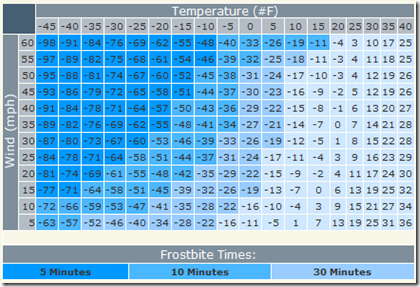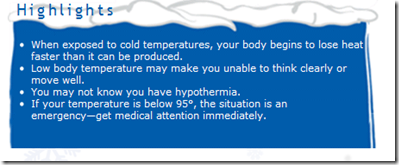NWS Weather warnings Jan 6th, 2013
# 8032
Although I’m a 2nd generation Floridian, I spent 10 years living in the often frozen backwoods of Missouri. Thankfully, the statute of limitations expired, and in 2005 I was finally able to return to my home state.
My back-to-the land decade taught me many things. I learned how to fell trees, how to split and stack cords of wood every summer, and how to maintain and operate a wood furnace.
But most of all . . . I learned to appreciate the comparatively mild winters in Florida.
But even semi-tropical Florida can see bitterly cold weather, although it rarely hangs around for more than a day or two. And unlike those who live in more northern climes, residents here in the deep south aren’t as prepared to deal with it.
With temperatures expected to dive into the single digits across Georgia and Alabama, and into the teens tonight in north Florida (high 20s, low 30s in my neck of the woods), aided and abetted by winds of 15-25 MPH along the Gulf coast, wind chills tonight across parts of central Florida could reach down into the single digits.
The combination of wind and ambient temperatures produce a wind-chill temperature – or how cold it really feels.

Tonight, in Tallahassee, Florida, the low temperature is expected to be 20 degrees and winds are forecast to be 15 mph. Combined, that’s a wind chill of 6°F degrees.
Plenty cold enough to induce hypothermia, or even cause frostbite, in unprotected individuals.
Invariably, the first really cold snap of the year in Florida brings a spate of house fires, and tragic carbon monoxide poisonings, due to rarely used and badly maintained heating equipment.
In Carbon Monoxide: A Stealthy Killer we looked at some of the common sources of this colorless and odorless gas, including faulty furnaces, snow blocked car exhaust pipes, attempts to use generators inside the house or garage . . . and the use of CO producing emergency heat sources like charcoal hibachis indoors.
The CDC’s MMWR released a report in 2005 called Unintentional Non--Fire-Related Carbon Monoxide Exposures --- United States, 2001—2003 that stated:
During 2001--2003, an estimated 15,200 persons with confirmed or possible non--fire-related CO exposure were treated annually in hospital EDs. In addition, during 2001--2002, an average of 480 persons died annually from non--fire-related CO poisoning. Although males and females were equally likely to visit an ED for CO exposure, males were 2.3 times more likely to die from CO poisoning. Most (64%) of the nonfatal CO exposures occurred in homes. Efforts are needed to educate the public about preventing CO exposure.
In Study: Most Children Sleep Through Fire Alarms we looked at a study that found 87% of children tested under the age of 10 failed to wake up, while those between the ages of 11 and 15 were awakened 56% of the time. Of the 27 children who actually woke up, 61% recognized the fire alarm, and slightly less than half realized they should get out of the house.
Each year more than 800 children die in house fires in the United States (cite Child Fire Casualties). Additionally, from the CDC’s Fire Deaths and Injuries: Fact Sheet, we learn:
Deaths from fires and burns are the third leading cause of fatal home injury (Runyan 2004). The United State’s mortality rate from fires ranks eighth among the 25 developed countries for which statistics are available (International Association for the Study of Insurance Economics 2009).
Although the number of fatalities and injuries caused by residential fires has declined gradually over the past several decades, many residential fire-related deaths remain preventable and continue to pose a significant public health problem.
Finally today, a few excerpts from the CDC’s Winter Weather recommendations on avoiding and treating hypothermia and frost bite.
Follow the links to read them in their entirety.
Winter Weather: Hypothermia
When exposed to cold temperatures, your body begins to lose heat faster than it can be produced. Prolonged exposure to cold will eventually use up your body’s stored energy.
The result is hypothermia, or abnormally low body temperature. Body temperature that is too low affects the brain, making the victim unable to think clearly or move well. This makes hypothermia particularly dangerous because a person may not know it is happening and won’t be able to do anything about it.
Recognizing Hypothermia
Warnings signs of hypothermia:
Adults:
- shivering, exhaustion
- confusion, fumbling hands
- memory loss, slurred speech
- drowsiness
Infants:
- bright red, cold skin
- very low energy
What to Do
If you notice any of these signs, take the person’s temperature. If it is below 95°, the situation is an emergency—get medical attention immediately.
If medical care is not available, begin warming the person, as follows:
- Get the victim into a warm room or shelter.
- If the victim has on any wet clothing, remove it.
- Warm the center of the body first—chest, neck, head, and groin—using an electric blanket, if available. Or use skin-to-skin contact under loose, dry layers of blankets, clothing, towels, or sheets.
- Warm beverages can help increase the body temperature, but do not give alcoholic beverages. Do not try to give beverages to an unconscious person.
- After body temperature has increased, keep the person dry and wrapped in a warm blanket, including the head and neck.
- Get medical attention as soon as possible.
Winter Weather: Frostbite
Recognizing Frostbite
At the first signs of redness or pain in any skin area, get out of the cold or protect any exposed skin—frostbite may be beginning. Any of the following signs may indicate frostbite:
- a white or grayish-yellow skin area
- skin that feels unusually firm or waxy
- numbness
A victim is often unaware of frostbite until someone else points it out because the frozen tissues are numb.
What to Do
If you detect symptoms of frostbite, seek medical care. Because frostbite and hypothermia both result from exposure, first determine whether the victim also shows signs of hypothermia, as described previously. Hypothermia is a more serious medical condition and requires emergency medical assistance.
If (1) there is frostbite but no sign of hypothermia and (2) immediate medical care is not available, proceed as follows:
- Get into a warm room as soon as possible.
- Unless absolutely necessary, do not walk on frostbitten feet or toes—this increases the damage.
- Immerse the affected area in warm—not hot—water (the temperature should be comfortable to the touch for unaffected parts of the body).
- Or, warm the affected area using body heat. For example, the heat of an armpit can be used to warm frostbitten fingers.
- Do not rub the frostbitten area with snow or massage it at all. This can cause more damage.
- Don’t use a heating pad, heat lamp, or the heat of a stove, fireplace, or radiator for warming. Affected areas are numb and can be easily burned.
These procedures are not substitutes for proper medical care. Hypothermia is a medical emergency and frostbite should be evaluated by a health care provider. It is a good idea to take a first aid and emergency resuscitation (CPR) course to prepare for cold-weather health problems. Knowing what to do is an important part of protecting your health and the health of others.
Finally, the CDC has put together all of their Winter Weather advice into a single PDF file which you can download at the link below.
Extreme Cold Prevention Guide (3.45 MB/15 pages)


